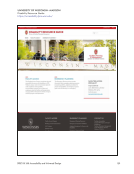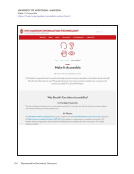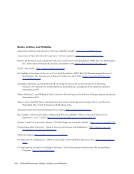43 SPEC Kit 358: Accessibility and Universal Design If your library has applied Universal Design for Learning principles in another setting, please briefly describe it. N=3 A new Instructional Design Librarian has been hired, and has plans to apply UD in more contexts in the future. Reference desk and consultations, as providing an extra monitor for the user. Research consultations ADDITIONAL COMMENTS 31. Please enter any additional information about accessibility services at your library that may assist the authors in accurately analyzing the results of this survey. N=22 Access and Equity Services (AES) is guided by Saskatchewan’s Human Rights legislation and the duty to accommodate individuals requiring accommodations based on disability, religion, family status, and gender identity. This campus-wide service is the first point of contact for students with disabilities, and the library partners with AES to support these students. Again, our libraries span the gamut from really old buildings with barriers to mobility, to much newer buildings and one library that’s being renovated as we speak. Accessibility is an issue that has come up in both these situations. The position of Librarian for Inclusion Initiatives is very new, and combines all areas of inclusion—not only accessibility. This SPEC survey will actually help with talking about how the library wants to approach accessibility in its future endeavors. For question #8: Is this regarding staff or just users? There is coordination support on different levels. We observed that there were no questions regarding service animals, campus partners, office hours in the SDRC, low tech assistive versus high assistive technologies, and neurodiverse populations. For question 10, we have answered for all library workstations. Library staff is not responsible for any aspect of the computers or equipment with assistive technology. Our library has been undergoing a redesign of our disability services. Most of our software had expired, thus at the time of this survey we still have very little specialized software in place. This survey has been helpful in pointing out other areas we need to consider. Thank you! Our new renovations will be including more accessibility features. Staff are becoming more familiar with the importance of accessibility for students, staff, and faculty. Our User Experience Librarian is currently involved with a campus-wide committee focusing on electronic and information technology accessibility. The group plans on introducing a campus-wide accessibility policy. Our library system has plans to form its own accessibility committee in order to become compliant and stay compliant with the policy. We anticipate that we will make many changes toward accessibility in the near future, including making sure our libraries’ website is complaint with WCAG 2.0 Level AA accessibility standards. I would like to mention that our submission reflects all our libraries in our system (our main library, our medical school library, and nine departmental libraries). The Assistive Technology Lab, while located inside the main library, is a service under the campus Accessibility and Disability Services. It is not administered by the Libraries. The ATLab/library relationship is covered under an MOU. ATLab services are available only to users registered with the campus ADS it is not open to all library users. The library has an ATLab/Library Liaison Group and an ATLab/Library Liaison Network. The campus IT Usability Lab for accessibility testing is co-located in the library. Library staff are participating in the special interest group for FOLIO on accessibility.




























































































































































